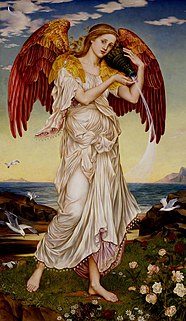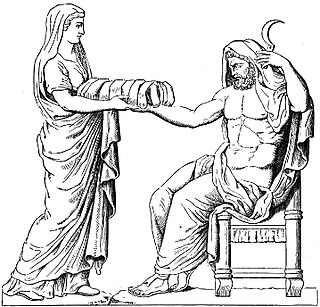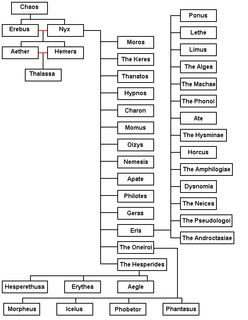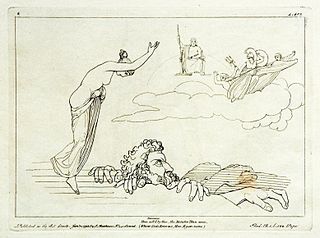In Greek mythology, Aeolus is a name shared by three mythical characters. These three personages are often difficult to tell apart, and even the ancient mythographers appear to have been perplexed about which Aeolus was which. Diodorus Siculus made an attempt to define each of these three, and his opinion is followed here.

In Greek mythology, Eos is a Titaness and the goddess of the dawn, who rose each morning from her home at the edge of the Oceanus.

Hermes is the god of trade, heraldry, merchants, commerce, roads, thieves, trickery, sports, travelers, and athletes in Ancient Greek religion and mythology; the son of Zeus and the Pleiad Maia, he was the second youngest of the Olympian gods.

A nymph in Greek mythology is a supernatural being associated with many other minor female deities that are often associated with the air, seas or water, or particular locations or landforms. Different from Greek goddesses, nymphs are more generally regarded as divine spirits who animate or maintain Nature for the environments where they live, and are usually depicted as beautiful, young graceful maidens. They are often divided into various broad subgroups, such as Aurai (winds), Hesperides, Nereides (seas), Naiades and Dryades

Poseidon was one of the Twelve Olympians in ancient Greek religion and myth. He was god of the Sea and other waters; of earthquakes; and of horses. In pre-Olympian Bronze Age Greece, he was venerated as a chief deity at Pylos and Thebes. His Roman equivalent is Neptune.

Zeus is the sky and thunder god in ancient Greek religion, who rules as king of the gods of Mount Olympus. His name is cognate with the first element of his Roman equivalent Jupiter. His mythologies and powers are similar, though not identical, to those of Indo-European deities such as Indra, Jupiter, Perkūnas, Perun, and Thor.

William Tyndale was an English scholar who became a leading figure in the Protestant Reformation in the years leading up to his execution. He is well known for his translation of the Bible into English.

Oceanus, also known as Ogenus or Ogen, was a divine figure in classical antiquity, believed by the ancient Greeks and Romans to be the divine personification of the sea, an enormous river encircling the world.

Rhea is a character in Greek mythology, the Titaness daughter of the earth goddess Gaia and the sky god Uranus as well as sister and wife to Cronus. In early traditions, she is known as "the mother of gods" and therefore is strongly associated with Gaia and Cybele, who have similar functions. The classical Greeks saw her as the mother of the Olympian gods and goddesses, but not as an Olympian goddess in her own right. The Romans identified her with Magna Mater, and the Goddess Ops.

In Greek mythology the Horae or Horai or Hours were the goddesses of the seasons and the natural portions of time.

In Greek mythology, Selene is the goddess of the moon. She is the daughter of the Titans Hyperion and Theia, and sister of the sun-god Helios, and Eos, goddess of the dawn. She drives her moon chariot across the heavens. Several lovers are attributed to her in various myths, including Zeus, Pan, and the mortal Endymion. In classical times, Selene was often identified with Artemis, much as her brother, Helios, was identified with Apollo. Selene and Artemis were also associated with Hecate, and all three were regarded as lunar goddesses, but only Selene was regarded as the personification of the moon itself. Her Roman equivalent is Luna.

In Greek mythology, Erebus, also Erebos, was often conceived as a primordial deity, representing the personification of darkness; for instance, Hesiod's Theogony identifies him as one of the first five beings in existence, born of Chaos.
In Greek mythology, Hyperion was one of the twelve Titan children of Gaia (Earth) and Uranus (Sky) who, led by Cronus, overthrew their father Uranus and were themselves later overthrown by the Olympians. With his sister, the Titaness Theia, Hyperion fathered Helios (Sun), Selene (Moon) and Eos (Dawn). Keats's abandoned epic poem Hyperion is among the literary works that feature the figure.

In ancient Greek religion and mythology, the twelve Olympians are the major deities of the Greek pantheon, commonly considered to be Zeus, Hera, Poseidon, Demeter, Athena, Apollo, Artemis, Ares, Aphrodite, Hephaestus, Hermes, and either Hestia or Dionysus. They were called 'Olympians' because, according to tradition, they resided on Mount Olympus.
The Greek alphabet has been used to write the Greek language since the late ninth or early eighth century BC. It is derived from the earlier Phoenician alphabet, and was the first alphabetic script to have distinct letters for vowels as well as consonants. In Archaic and early Classical times, the Greek alphabet existed in many different local variants, but, by the end of the fourth century BC, the Eucleidean alphabet, with twenty-four letters, ordered from alpha to omega, had become standard and it is this version that is still used to write Greek today. These twenty-four letters are: Α α, Β β, Γ γ, Δ δ, Ε ε, Ζ ζ, Η η, Θ θ, Ι ι, Κ κ, Λ λ, Μ μ, Ν ν, Ξ ξ, Ο ο, Π π, Ρ ρ, Σ σ/ς, Τ τ, Υ υ, Φ φ, Χ χ, Ψ ψ, and Ω ω.
In Greek mythology, Pallas was one of the Titans. According to Hesiod, he was the son of Crius and Eurybia, the brother of Astraeus and Perses, the husband of Styx, and the father of Zelus, Nike ("Victory"), Kratos, and Bia. Hyginus says that Pallas, whom he calls "the giant", also fathered with Styx: Scylla, Fontes ("Fountains") and Lacus ("Lakes"). Pallas was sometimes regarded as the Titan god of warcraft and of the springtime campaign season.

In Greek mythology, Cronus, Cronos, or Kronos, was the leader and youngest of the first generation of Titans, the divine descendants of Uranus, the sky, and Gaia, the earth. He overthrew his father and ruled during the mythological Golden Age, until he was overthrown by his own son Zeus and imprisoned in Tartarus. According to Plato, however, the deities Phorcys, Cronus, and Rhea were the eldest children of Oceanus and Tethys.

In Greek mythology, Gaia, also spelled Gaea, is the personification of the Earth and one of the Greek primordial deities. Gaia is the ancestral mother of all life: the primal Mother Earth goddess. She is the immediate parent of Uranus, from whose sexual union she bore the Titans and the Giants, and of Pontus, from whose union she bore the primordial sea gods. Her equivalent in the Roman pantheon was Terra.

Uranus was the primal Greek god personifying the sky and one of the Greek primordial deities. Uranus is associated with the Roman god Caelus. In Ancient Greek literature, Uranus or Father Sky was the son and husband of Gaia, Mother Earth. According to Hesiod's Theogony, Uranus was conceived by Gaia alone, but other sources cite Aether as his father. Uranus and Gaia were the parents of the first generation of Titans, and the ancestors of most of the Greek gods, but no cult addressed directly to Uranus survived into Classical times, and Uranus does not appear among the usual themes of Greek painted pottery. Elemental Earth, Sky, and Styx might be joined, however, in a solemn invocation in Homeric epic.

The Hecatoncheires, also called the Centimanes or Hundred-Handers, were figures in the archaic, pre-Olympian era within Greek mythology, three giants of incredible strength and ferocity that surpassed all of the Titans, whom they helped overthrow. Their name derives from the Greek ἑκατόν and χείρ, "each of them having a hundred hands and fifty heads". The Hundred-Handed-Ones are "giants" of great storms and hurricanes.



















